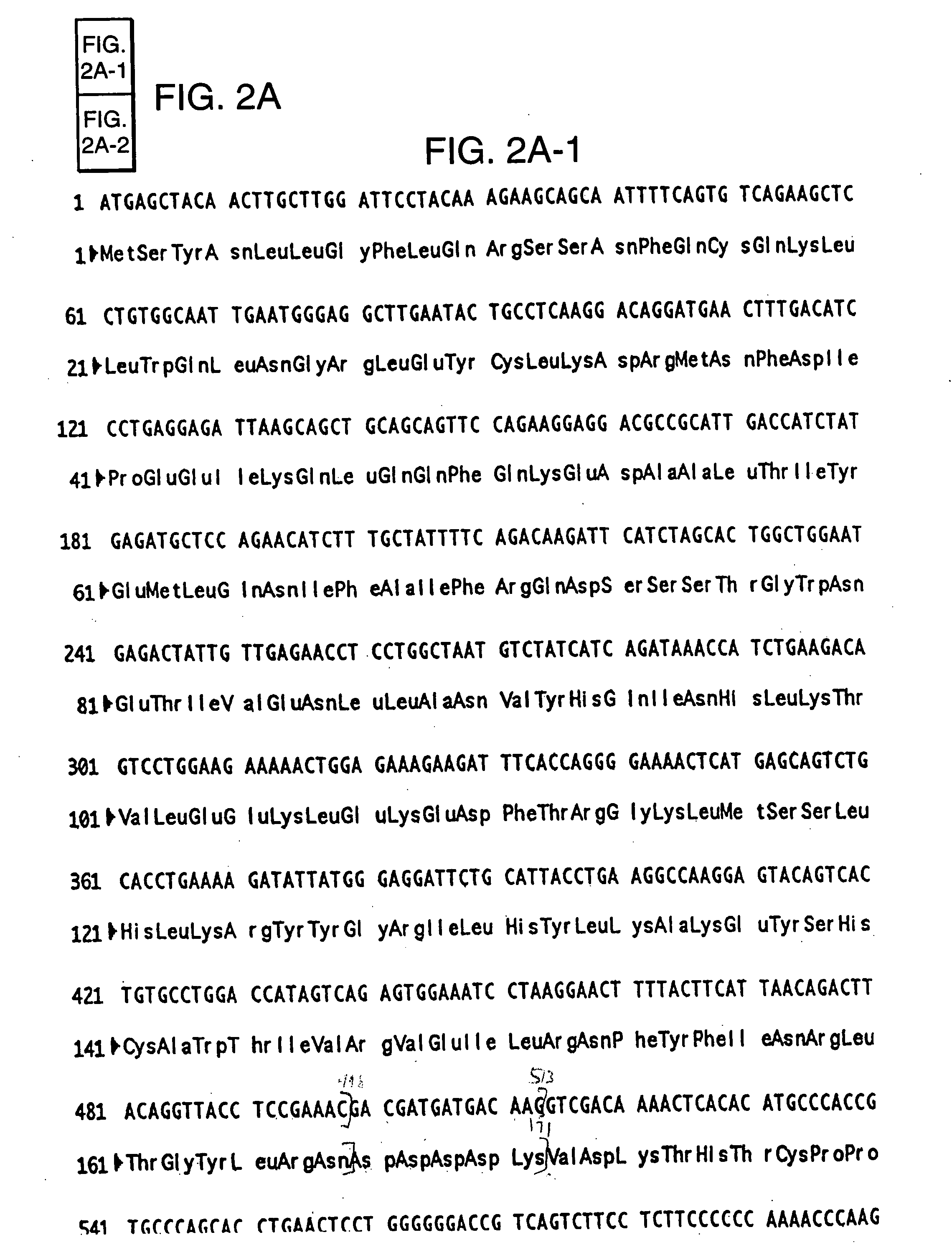Interferon-beta fusion proteins and uses
a technology of interferon and beta, which is applied in the field of interferonbeta fusion proteins and uses, can solve the problems of the use of these proteinaceous substances for their use, and achieve the effects of reducing the use ra
- Summary
- Abstract
- Description
- Claims
- Application Information
AI Technical Summary
Benefits of technology
Problems solved by technology
Method used
Image
Examples
example 1
Structure / Activity Studies of Human Interferon-Beta-1a Using Alanine / Serine Substitution Mutations: Analysis of Receptor Binding Sites and Functional Domains
A. Overview
[0116] An extensive mutational analysis of human interferon-beta-1a (IFN-beta-1a) was undertaken with the aims of mapping residues required for activity and receptor binding. The availability of the 3-D crystal structure of human IFN-beta (Karpusas, M. et al. 1997, Proc. Natl. Acad. Sci. 94: 11813-11818) allowed us to identify for alanine (or serine) substitutions the solvent-exposed residues available for receptor interactions, and to retain amino acids involved in intramolecular bonds. A panel of 15 alanine substitution mutations were designed that replaced between 2 and 8 residues along distinct regions of each of the helices (A, B, C, D, E) and loops (AB, CD, DE). An amino-terminal tag consisting of 6 histidine residues was included for affinity purification, as well as an enterokinase linker sequence site for ...
example 2
Construction of Plasmids for Expression of Interferon-Beta-1a Fusion (IFN-Beta / Fc) Protein
[0148] PCR technology was employed to create an expression plasmid encoding the human IFN-beta DNA sequence fused to the Fc portion of murine IgG2a heavy chain molecule. The plasmid vector pDSW247 (see Example 1) is a derivative of pCEP4 (Invitrogen, Carlsbad, Calif.), from which the EBNA-1 gene has been deleted. This plasmid was used for the construction of an expression vector useful for transient protein expression in EBNA 293 human kidney cells (Invitrogen, Carlsbad, Calif., Shen. E. S., et. al. 1995, Gene 156, 235-239). It was designed to contain a human vascular cell adhesion molecule-I (VCAM-1) signal sequence in frame and upstream of the interferon beta sequence, and an enterokinase linker sequence at the junction of the interferon beta and Ig sequences.
[0149] The fusion protein expression cassette was assembled from several DNA fragments. To obtain a DNA fragment encoding the human I...
example 3
Production of Interferon-Beta-1a Fusion Protein in Mammalian Cells
[0154] The recombinant IFN-beta / Fc expression vector, pCMG261 was transiently tranfected into human EBNA 293 kidney cells to achieve expression of an IFN-beta-1a fusion protein of the invention. This recombinant expression plasmid is transfected by the lipofectamine protocol (catalogue # 18324-020, Life Techonologies) in EBNA 283 human kidney cells according to the protocol of the manufacturer (Life Technologies, Gaithersburg, Md., Hawley-Nelson, P., Ciccarone, V., Gebeyehu, G. Jessee, J., Felgner, P. L. (1993) Focus 15.73) using 1-3 micrograms plasmid DNA for a 100 mm culture dish of EBNA 293 cells. On the the day following lipofectamine transfection of cells, the media is replaced with growth media (Dulbecco's modified Eagle's medium, 10% fetal bovine serum, 4 mM glutamine, 250 micogram Gentecin / ml (Life Technologies, Gaithersburg, Md.). The conditioned media is harvested 34 days later and the concentration of IFN-...
PUM
| Property | Measurement | Unit |
|---|---|---|
| temperature | aaaaa | aaaaa |
| concentrations | aaaaa | aaaaa |
| concentrations | aaaaa | aaaaa |
Abstract
Description
Claims
Application Information
 Login to View More
Login to View More - R&D
- Intellectual Property
- Life Sciences
- Materials
- Tech Scout
- Unparalleled Data Quality
- Higher Quality Content
- 60% Fewer Hallucinations
Browse by: Latest US Patents, China's latest patents, Technical Efficacy Thesaurus, Application Domain, Technology Topic, Popular Technical Reports.
© 2025 PatSnap. All rights reserved.Legal|Privacy policy|Modern Slavery Act Transparency Statement|Sitemap|About US| Contact US: help@patsnap.com



